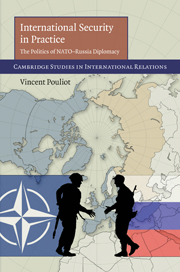Book contents
- Frontmatter
- Contents
- List of Figures and tables
- Preface
- Abbreviations
- 1 Introduction
- Part I Restoring the practical logic of peace
- Part II The symbolic power politics of NATO–Russia diplomacy
- 4 The logic of practicality at the NATO–Russia Council
- 5 The early steps: NATO, Russia and the double enlargement, 1992–1997
- 6 The fallout: NATO and Russia from Kosovo to Georgia, 1998–2008
- 7 Conclusion
- Bibliography
- Index
- Cambridge Studies in International Relations
6 - The fallout: NATO and Russia from Kosovo to Georgia, 1998–2008
Published online by Cambridge University Press: 03 May 2010
- Frontmatter
- Contents
- List of Figures and tables
- Preface
- Abbreviations
- 1 Introduction
- Part I Restoring the practical logic of peace
- Part II The symbolic power politics of NATO–Russia diplomacy
- 4 The logic of practicality at the NATO–Russia Council
- 5 The early steps: NATO, Russia and the double enlargement, 1992–1997
- 6 The fallout: NATO and Russia from Kosovo to Georgia, 1998–2008
- 7 Conclusion
- Bibliography
- Index
- Cambridge Studies in International Relations
Summary
Hysteresis and symbolic power struggles continued to plague NATO–Russia diplomacy well into the twenty-first century. Pursuing the historical analysis of practices, in this chapter I focus on the period stretching from NATO's intervention in Kosovo to the war between Russia and Georgia. During this decade, the Alliance continued its double enlargement policy by conducting a range of new military operations outside the Euro-Atlantic zone and admitting ten new member states. Because my objective is to trace the roots of the practical sense of diplomats at the NRC as I recordered it in 2006 (see Chapter 4), I mainly concentrate on the period up until that year. In the final section of the chapter, I briefly extend my narrative to more recent NATO–Russia diplomacy and show that it basically followed the same pattern of increasing symbolic power struggles that began back in late 1994.
Despite the fact that Russia and NATO member states successfully dealt with their fierce disagreements over the double enlargement in a non-violent manner, hysteresis was compounded between 1998 and 2008 as the disconnect between positions and dispositions increased consistently. After the Kosovo crisis, Great Power dispositions grew stronger among the Moscow foreign policy elites, even though the country's position remained weak by NATO standards. Then, in the wake of September 11, 2001, the rules of the international security game partly shifted back to “hard security,” an evolution that temporarily played to Russia's advantage.
- Type
- Chapter
- Information
- International Security in PracticeThe Politics of NATO-Russia Diplomacy, pp. 194 - 230Publisher: Cambridge University PressPrint publication year: 2010
- 1
- Cited by



